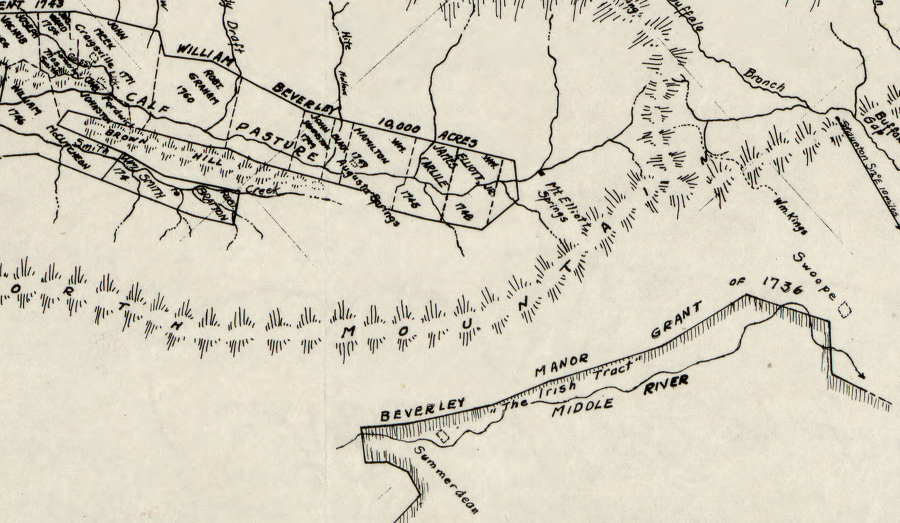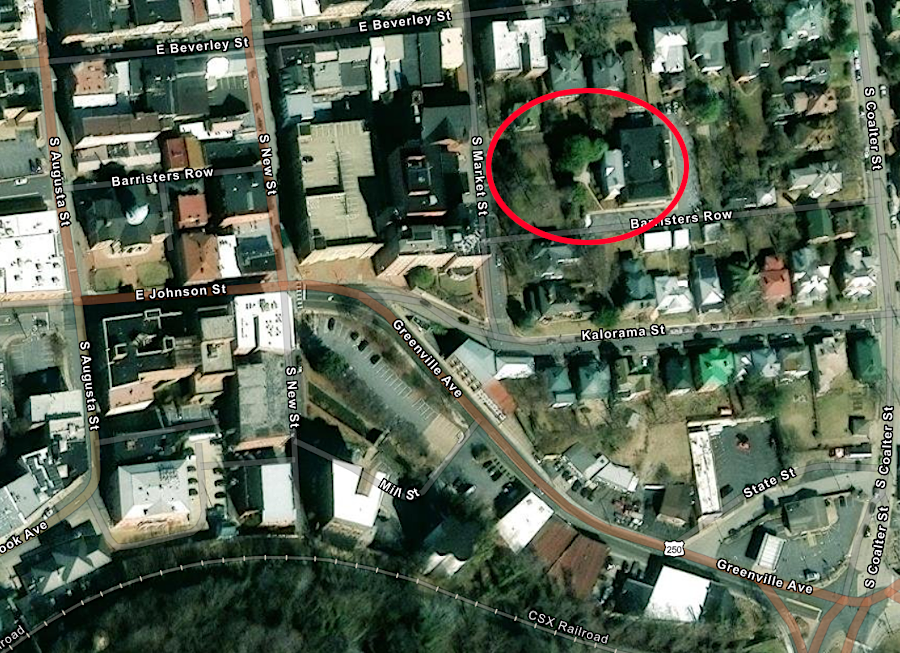
William Beverley acquired land on the Little Calfpasture River
Source: Library of Congress, Colonial land patents and grantees: Calfpasture Rivers, Augusta County, Virginia (by Meredith Leitch, 1947)

William Beverley acquired land on the Little Calfpasture River
Source: Library of Congress, Colonial land patents and grantees: Calfpasture Rivers, Augusta County, Virginia (by Meredith Leitch, 1947)
Governor Gooch decided to issue large land grants west of the Blue Ridge, but Lord Fairfax's agents protested the authority of the colonial officials in Williamsburg to dispose of land within the boundaries of the Fairfax Grant. The dispute delayed final issuance of tile to grants made to John and Isaac Van Meter and to Joist Hite, in the lower (northern) part of the Shenandoah Valley.
On September 6, 1736, as surveyors were marking the boundaries of the Fairfax Grant, Governor Gooch and his Council in Williamsburg approved a large (118,491 acre) grant to William Beverley. The boundaries of the Beverley grant were located south of the "back line" of the Fairfax Grant, the line connecting the headsprings of the Rappahannock and Potomac rivers.
William Beverley was a member of the gentry, the elite Virginians who acquired land, slaves, wealth, and status. In 1716 the Knights of the Golden Horseshoe had stopped at his family's plantation on their expedition to cross the Blue Ridge. His father Robert Beverley had accompanied Governor Spotswood into the Shenandoah Valley, and in 1705 had written The History and Present State of Virginia, In Four Parts.1
William Beverley was elected to the House of Burgesses from Orange County and then from Essex County. His grant included much of modern-day Augusta County and the city of Staunton.
According to the generous terms of the grant, Beverley was entitled to 1,000 acres for every family that he recruited to settle on his tract.2
Beverley built a mill on a stream and then a mansion house. His tract became known as Beverley's Manor, though he had no feudal rights to govern the residents who settled there. Though he built an impressive brick house, William Beverley personally chose to live at his family plantation in Essex County. The house later became the Staunton Public Library.3

William Beverley's mansion house was later used as the Staunton Public Library
Source: ESRI, ArcGIS Online
Beverley and Benjamin Borden, who had been granted 100,000 acres south of William Beverly's land, both recruited Scotch-Irish settlers from Pennsylvania and Ireland. The two grantees generated income from their land grants only when they had actual settlers willing to purchase parcels.
The people they recruited included many Presbyterians who had fled northern Ireland. The English government had depressed the Irish economy by the 1699 Woolen Act, banning the export of textiles except across the Irish Sea to England. The 1703 Test Act had required everyone to convert to the established Anglican Church in order to vote, and constrained the Presbyterian churches in Ireland.
Starting in 1717, after English landlords raised rents in Ireland, nearly 50,000 people emigrated to North America over the next sixty years. A primary destination was Pennsylvania, where William Penn and his Quakers had created a colony that welcomed different religious faiths.4
William Beverley arranged for an Irish ship captain, James Patton, to recruit families to settle the grant. In exchange, Patton would be paid in land. It is unclear how Beverley was acquainted with Patton, but it is possible that the two were somehow associated with smuggling tobacco into Britain.
In an August 9, 1737, letter Beverley wrote to Patton:5
John Lewis moved his family from Lancaster, Pennsylvania to Beverley's Manor in 1732. He acquired 2,000 acres on what today is known as Lewis Creek and built a house he called Bellefonte.
As Presbyterians began to migrate south along the Great Road (later US 11 and then I-81) and fill up the Shenandoah Valley, the Presbyterian Synod of Philadelphia got Governor Gooch to affirm in 1738 that the Virginia colony - in which the Church of England was officially "established" - would not discriminate against them.
The governor only required that the dissidents register the religious meeting places. The Presbyterian churches were built with private funds; the Anglican churches were constructed with public tax revenue. The first Presbyterian minister, Rev. John Craig, settled near Lewis Creek in 1740.
An Anglican vestry was not organized until 1746 and the first Anglican minister, Rev. John Hindman, did not arrive until 1747. The 200 acre glebe, which generated revenue for the minister to support his salary, was purchased in 1748.
Presbyterian landowners in the area dominated the vestry, and ministers from the two faiths preached on separate Sundays in the Augusta County courthouse. Choosing dissenters for an Anglican vestry caused some concern, but evidently was acceptable to William Beverley. A petition to allow only Anglicans to serve was rejected by the General Assembly.6
A large number of German-speaking settlers arrived after the Scotch-Irish. The first Lutheran Church was built in 1780.7
When William Beverley received his grant, the land was in Orange County. That courthouse was east of the Blue bidge, so traveling to it in order to process land deeds was burdensome. The General Assembly anticipated population growth by chartering Frederick and Augusta counties in 1738, but recognized that the current population was insufficient to pay the taxes required to build a courthouse and pay justices of the peace and other county officials.
The militia was organized starting in 1741, but Augusta County justices of the peace were not appointed until 1745. Beverley donated 25 acres for the courthouse lot, but some settlers opposed the location because there was no spring nearby. The controversy was settled by the General Assembly in which Beverley was influential, and his preference for the site of the county seat was selected. He had already built a log cabin structure to serve as the courthouse.
The new community was known first as Augusta Court House. In 1761, the town was established and named Staunton after the wife of Governor Gooch.8